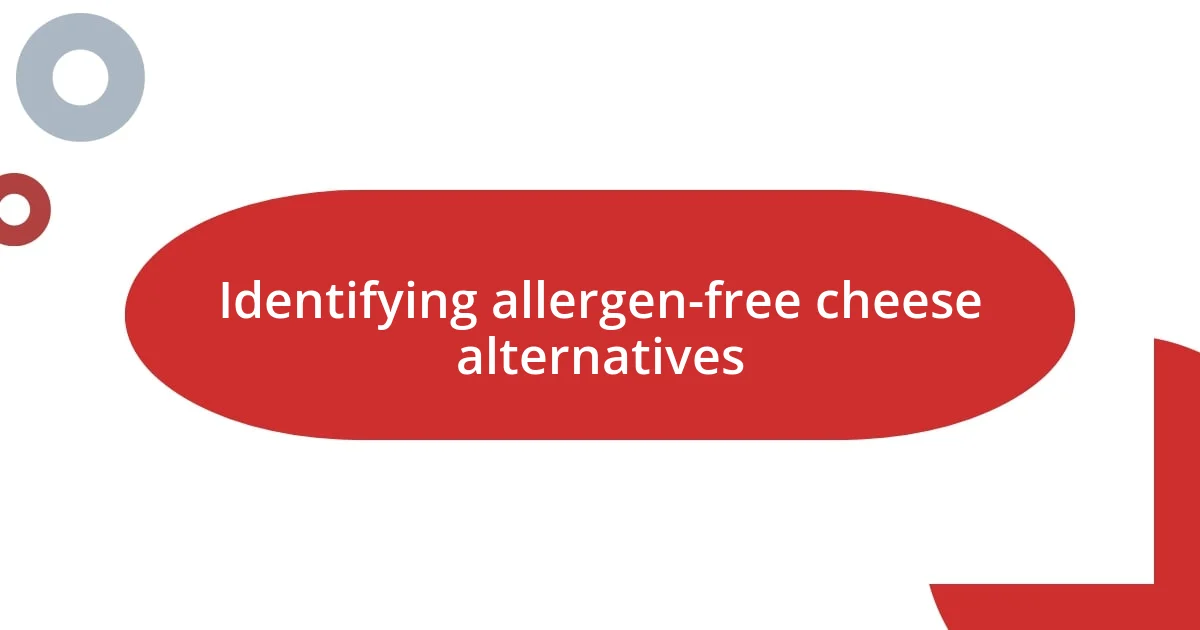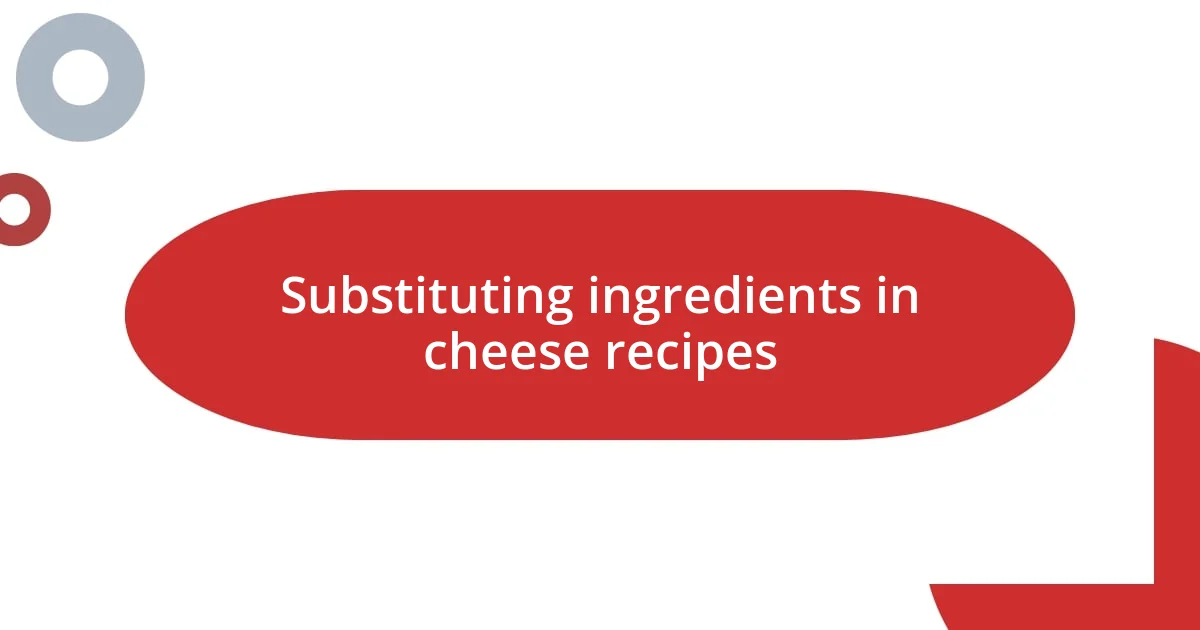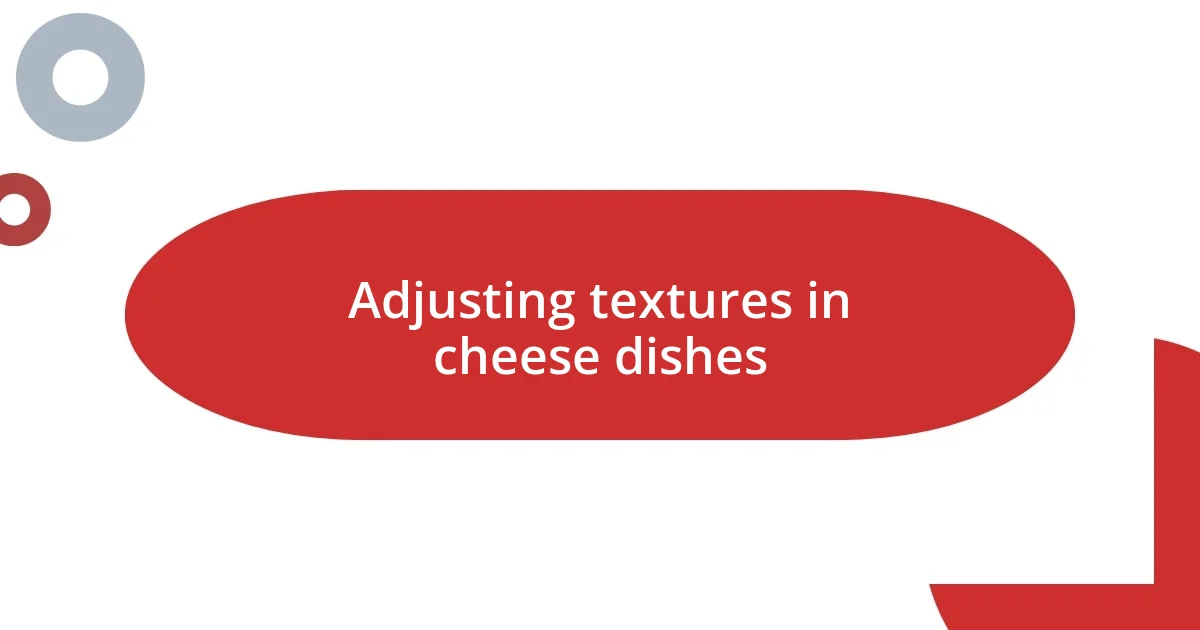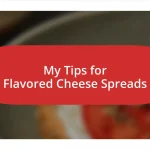Key takeaways:
- Lactose intolerance and milk protein allergies are common issues that can significantly impact dietary choices, making it essential to understand and communicate these restrictions.
- Using allergen-free alternatives like nutritional yeast, tofu, and nut-based cheeses can create delicious dishes without compromising on texture or flavor.
- Experimenting with ingredients, testing small batches, and keeping a food diary can enhance the cooking experience and lead to successful allergy-friendly recipes.

Understanding common cheese allergies
When it comes to cheese allergies, many people are surprisingly unaware that lactose intolerance and milk protein allergies come into play quite frequently. Personally, I’ve seen friends sideline their favorite cheese dishes because they underestimate the impact of lactose on their bodies. Have you ever had that awkward moment at a dinner party when you realize that cheese platter is your nemesis?
Lactose intolerance occurs when the body struggles to break down lactose, the sugar found in milk and dairy products. This can lead to discomfort ranging from bloating to some serious digestive distress. I remember the first time I tried a trendy cheese board with my lactose-intolerant friend—we both thought it would be safe, thinking a little indulgence wouldn’t hurt. Spoiler: it did.
On the other hand, milk protein allergies, like those related to casein or whey, can provoke even more severe reactions, including hives or anaphylaxis. This can be alarming for someone who loves cheese. It’s vital to read labels and communicate openly with others about dietary restrictions. Have you ever felt the pressure at a gathering to fit in with the food choices, even when they might not fit your health needs? It’s a common struggle, but understanding these allergies can empower you to make safer decisions.

Identifying allergen-free cheese alternatives
Finding allergen-free cheese alternatives can feel overwhelming at times, but I’ve discovered some excellent options through trial and error. It’s all about knowing what to look for and what flavors work best in different recipes. For example, nut-based cheeses have become a go-to for me. I remember hosting a small gathering and offering a homemade cashew cheese spread—it was a hit! Everyone loved it, and I didn’t have to worry about allergens.
Here are some popular allergen-free cheese alternatives to consider:
- Nutritional Yeast: This flaky seasoning gives dishes a cheesy flavor without any dairy.
- Tofu: Blended or crumbled, it can mimic the texture of ricotta or cottage cheese.
- Coconut Cream: For a rich, creamy base that works well in sauces and spreads.
- Soy Cheese: Often lactose-free, though you should check for soy allergies.
- Cashew Cheese: A smooth, creamy alternative that can be flavored with herbs and spices.
Experimenting with these ingredients has opened up a whole new world of cheesy goodness that everyone can enjoy, regardless of dietary restrictions.

Substituting ingredients in cheese recipes
Substituting ingredients in cheese recipes can truly transform a dish while accommodating various allergies. When I first started experimenting, I was a bit hesitant, fearing that the flavors would fall flat. I remember making a mac and cheese for a friend with lactose intolerance, and I replaced regular cheddar with a blend of nutritional yeast and cashew cream. The result was surprisingly delightful, with a flavor that brought smiles all around the table. Have you ever discovered a surprising ingredient substitution that changed your perspective on a dish?
Another effective strategy is to use plant-based options to mimic the texture of traditional cheese. I’ve found that blended tofu can effectively replicate ricotta in lasagna, creating layers of creamy goodness without any dairy. One evening, I managed to impress my dairy-loving family with a tofu-based stuffing in a classic pasta bake, and they were none the wiser about the substitution. It’s moments like these that highlight how versatile our ingredient choices can be, allowing everyone to feel included and satisfied.
While it might seem daunting at first, the world of ingredient substitutions is rich with possibilities. From indulging in dairy-free cheese spreads to exploring nut-based alternatives, there’s so much creativity involved. It’s essential to taste as you go—you might stumble upon an unexpected flavor harmony that elevates your dish beyond your wildest expectations. Plus, incorporating allergen-friendly swaps opens the door to new culinary adventures.
| Ingredient | Substitution |
|---|---|
| Cheddar Cheese | Nutritional Yeast + Cashew Cream |
| Ricotta Cheese | Blended Tofu |
| Cream Cheese | Coconut Cream + Nutritional Yeast |
| Parmesan Cheese | Dairy-Free Parmesan or Almond Flour |

Adjusting textures in cheese dishes
Adjusting the texture in cheese dishes can take a bit of finesse, but it’s all part of the fun! When I’m crafting a creamy risotto without dairy, I find that adding a splash of almond milk and a bit of blended cauliflower provides that rich mouthfeel I crave. It’s amazing how the right combination of ingredients can mimic that dreamy velvety texture we usually associate with cheese. Have you ever tried a similar hack? It could completely change your outlook on dairy-free cooking.
For a delightful variety, consider how the incorporation of vegetables can enhance the overall dish. I once made a savory tart with a crust made from ground oats and added puréed sweet potatoes as a cheesy substitute. This not only gave it a gorgeous color but also a pleasing texture that married well with the crispy crust. The way every bite melded together was satisfying; it’s little victories like this that encourage me to experiment even more with textures to surprise my eating companions.
Don’t shy away from using seeds and nuts—these can work wonders. I love making a cheese-like spread with sunflower seeds blended to a silky smoothness; adding some nutritional yeast really amps up that cheesy tang. It’s a wonderful reminder that we can achieve rich textures using the simplest of ingredients. Have you found any nut or seed-based options that knocked your socks off? I truly believe the journey of texture exploration in allergen-friendly cooking can lead to delicious discoveries!

Enhancing flavors without allergens
When it comes to enhancing flavors while keeping allergens at bay, spices and herbs can be your best allies. The first time I made a vegan cheese sauce for nachos, I was worried it would taste bland. I decided to play around with smoked paprika and garlic powder, and wow, what a game changer! The smoky, savory notes elevated the entire dish, making it absolutely irresistible. Have you ever noticed how just a pinch of the right seasoning can spark joy in a dish?
I also find that adding acidity can really bring out flavors without the need for dairy. One memorable evening, I whipped up a creamy avocado spread, and to my surprise, a few drops of lemon juice transformed it from good to spectacular. It brightened the richness of the avocado and left everyone at the table asking for the recipe. Isn’t it fascinating how a little tartness can create such a balance?
Moreover, umami-rich ingredients can mimic that desirable depth often found in traditional cheeses. I remember incorporating miso paste into a dairy-free cheese dip, and the result was nothing short of magical. The savory profile lingered on the palate in such an inviting way that it convinced my friends—it’s all about exploring these unique flavor avenues! What unexpected umami boost have you added to your own recipes?

Testing new recipes safely
When testing new recipes, especially those adjusted for allergies, I always start with a small batch. A while back, I was experimenting with a cashew-based cheese for a family gathering. I hoped it would impress, but I had to ensure all ingredients were safe for my uncle’s nut allergy. By testing a small portion first, I was able to tweak the flavors without wasting an entire dish. Have you ever found yourself in a similar situation where a small test saved the day?
I also find it crucial to involve friends or family members who share similar dietary restrictions during my cooking experiments. One memorable afternoon, my friend and I made dairy-free mac and cheese using nutritional yeast and blended butternut squash. We eagerly tasted the dish as it cooked, and to our delight, it met our expectations! Their feedback not only validated my efforts but also encouraged us to innovate further. Isn’t it comforting to have companions on this culinary journey?
Lastly, keeping a food diary can be a game changer. I jot down notes on each recipe, including what worked and what didn’t—like the time I added too much lemon to a dairy-free cream. It ended up being too tart, but I learned a valuable lesson in balance. Tracking these insights not only enhances my future cooking but also creates a personalized reference for perfecting allergen-free cuisine. How do you document your own culinary adventures?

Tips for allergy-friendly cheese dishes
When crafting allergy-friendly cheese dishes, I’ve discovered that texture plays a vital role in replicating that creamy satisfaction we often crave. I remember my first attempt at a coconut-based cheese spread; blending it until velvety smooth made all the difference! Have you ever noticed how important the right consistency can be for a dish to feel decadent, even if it’s dairy-free?
Another tip that has really worked for me is to explore alternative bases like cashews, tofu, or even cauliflower. I recall making a cheesy cauliflower soup that completely changed my perspective on dairy-free options. I roasted the cauliflower first to enhance its natural sweetness, then blended it with nutritional yeast for that cheesy flavor. The result? A comforting bowl that left everyone asking for seconds! What’s your go-to ingredient for achieving that creamy texture without the allergens?
Lastly, I always keep an eye out for store-bought products that align with allergy-friendly diets. One time, I stumbled upon a fantastic brand of plant-based cream cheese that transformed my bagels into a gourmet breakfast staple. It was a little pricey, but the convenience and flavor were totally worth it! Have you ventured into the world of dairy alternatives? Finding hidden gems can truly expand our culinary creativity!












